
Inspired by a mythical African Kingdom, The Palace of the Lost City, is the centrepiece of South Africa’s Sun City Resort. From its soaring domes and hand-painted ceilings to its mosaic floors and bronze sculptures, every corner of this hotel tells a story of adventure and discovery!
Around a two-hour drive from Johannesburg, Sun City is set within the rugged beauty of South Africa’s North West Province, providing a beautiful backdrop to the resort’s several swimming pools, and its two Gary Player-designed championship golf courses. There is also a host of restaurants to choose from, and a casino for those who enjoy a flutter.
Less than 5 km away is the southern gate of the wildlife-rich Pilanesberg National Park, giving you the chance to spot Africa’s ‘Big 5’ on a Sun City and safari holiday.
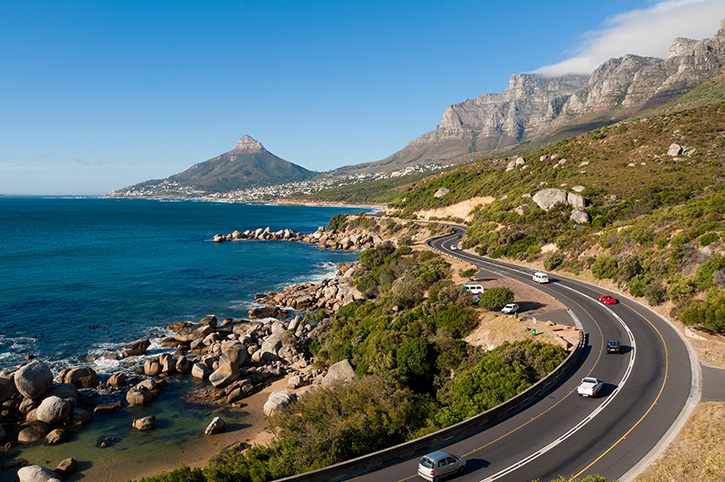
The Garden Route is a 190 mile stretch of coastline, making one of the most iconic and picturesque road trips in the world. As you travel from Mossel Bay in the Western Cape to the mouth of the Storms River in the Eastern Cape, you’re sandwiched between dramatic mountain passes and golden beaches.
This is a journey packed with breathtaking views, wildlife encounters and charming towns. Highlights along the route include the quaint town of Knysna, famous for its lagoon and fresh oysters, the beaches of Plettenberg Bay, and Tsitsikamma National Park, where suspension bridges lead you over river gorges and into ancient forests. Add a few days on safari in the Eastern Cape and you’ll have the perfect mix of coast, culture and wildlife.
We’d recommend allowing yourself at least six or seven days for the self drive from Cape Town to Port Elizabeth, or you can opt to take a small group tour.

This stunning panoramic viewpoint has become somewhat of a local legend. Enjoy the feeling of being on top of the world, as you watch the sun begin to disappear behind the mountains from your perch upon the giant boulders.
Samburu National Reserve’s semi-arid savannah and acacia scrublands stretch as far as the eye can see, offering a more remote safari experience than the National Parks in the south of Kenya. They are also home to some quite unique species, namely Besia oryx, reticulated giraffe, Grevy’s zebra, gerenuk and Somali ostrich, collectively known as the Samburu ‘Special 5’.
Accompanied by your guide, it’s a leisurely 40 minute stroll, or short drive, from Sasaab Samburu safari camp to ‘Sundowner Rock’. You can experience it for yourself on our three day Samburu fly-in safari.

Welcome Mahé, the largest island in the tropical archipelago of the Seychelles.
As you can see, you’ll find some breathtaking beaches, but you can also expect forest-clad mountains, idyllic resorts and vibrant Creole culture.
The capital, Victoria, has a ‘fun-sized’ replica of Big Ben and the colourful Sir Selwyn Selwyn-Clarke Market, where you can wander through stalls vending crafts, spices and tropical fruits. The Seychelles National Botanic Gardens offer an insight into the islands’ unique fauna and flora, with giant tortoises, endemic tropical plants and the famous Coco de Mer palms. Across the island, make sure to try Creole cuisine; a unique fusion of African, French, Indian and Chinese dishes.
Mahé also makes a great starting point for a Seychelles island-hopping holiday.
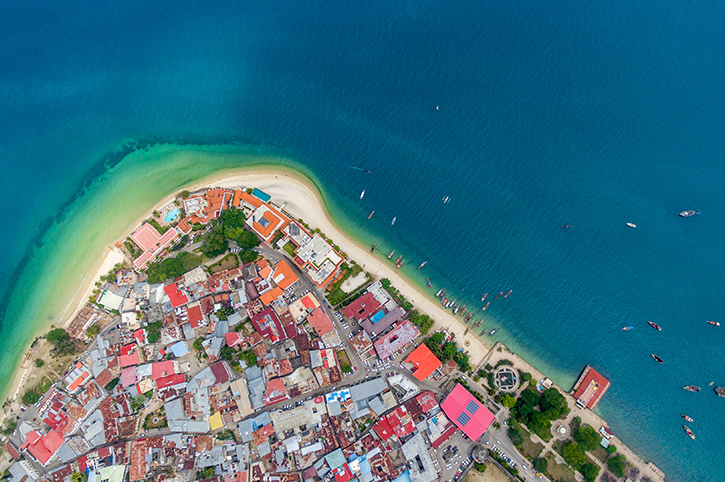
Zanzibar is mostly known for its tropical beaches and relaxing resorts, but Stone Town, the historic centre of the island’s largest town, offers the best of both worlds. It is full of character, history and culture, fringed by a pristine, white sand beach.
Developed as a Swahili trading town, the major buildings from the 18th and 19th centuries reflect Arab, Indian and European influences, combined with indigenous East African elements. A short stroll through the cobbled streets of Stone Town reveals a maze of bazaars and markets. Here you can visit traditional stalls offering fresh ginger, nutmeg and cinnamon amongst other exotic spices. If you visit early enough you can also select dinner from the local fishermen’s catch.
From the markets continue through the haphazard streets and alleyways to view one of the unique features of this historic town; Stone Town is home to more than 500 beautifully carved doors and doorways. Many of the heavy wooden doors are hand carved and decorated, creating individual and unique artworks around each corner.
For those seeking a city and beach break, Stone Town is a great destination, or it makes the perfect twin centre holiday following a Tanzania or Kenya safari.

Regarded as one of the best places in the world for a safari, the Masai Mara National Reserve is an incredible destination. Situated in southwest Kenya, along the Tanzanian border, this 1,510 km² area of savannah wilderness is home to a wealth of wildlife.
On a game drive through the park, you can expect some magical sightings. As well as wildlife like cheetahs, giraffes and hippos Masai Mara is home to the ‘Big 5’ safari animals: lions, leopards, elephant, rhino and buffalo.
July to October every year makes a particularly special time to visit the Masai Mara, as this is when the Great Migration takes place. This phenomenon has to be seen to be believed, as huge herds of wildebeest, zebra, impala and gazelle come thundering across the reserve’s vast plains, in search of better land for grazing.
Why not combine a Masai Mara safari with a beach escape on the breathtaking Mombasa coast on a safari and beach holiday.

On the west coast of Mahé, the fabulous 5-star Constance Ephelia resort spans a 120 hectare jungle clad peninsula with a beautiful beach on either side, where you can relax on the soft sands or enjoy complimentary kayaking or pedal boating. There is also a choice of five swimming pools, set amongst tropical gardens, a wonderful selection of bars and restaurants, four tennis courts, a children’s club and a health spa.
If you can tear yourself away from the resort, the Seychelles has so much to explore. For the energetic, a hike to the summit of its tallest mountain, Morne Seychellois, offers spectacular views across the Mahé and the Indian Ocean. For beach lovers a day tour to neighbouring La Digue is a must, home to the famous Anse Source d’Argent beach.

Set in the heart of Zambia’s breathtaking Lower Zambezi National Park, Chiawa Camp offers an unrivalled safari experience in one of Africa’s most pristine wilderness areas. The park’s stunning landscapes, from the mighty Zambezi River to its lush floodplains and the dramatic Zambezi Escarpment, provide the perfect backdrop for incredible wildlife encounters. Elephants, buffalo, lions, leopards, and an abundance of birdlife thrive here, making it a premier safari destination.
Chiawa Camp blends luxury with authenticity, offering beautifully designed tented suites overlooking the river. Each suite is elegantly furnished, featuring open-air bathrooms and private decks where guests can watch wildlife passing by. The camp is renowned for its expert guiding and personalised service, ensuring an unforgettable stay.
A variety of activities allow guests to explore the Lower Zambezi in different ways. Game drives and walking safaris offer thrilling land-based encounters, while canoeing and boat safaris provide a unique perspective of the river’s wildlife. Fishing enthusiasts can try their luck with catch-and-release tiger fishing, a popular highlight.
Beyond its exceptional safari experiences, Chiawa Camp is dedicated to conservation and sustainable tourism, ensuring the park’s protection for future generations. Whether tracking big cats, gliding along the river at sunset, or simply soaking in the natural beauty from your suite, a stay at Chiawa Camp is a truly unforgettable experience in Zambia’s wild and beautiful Lower Zambezi.

Zanzibar is an idyllic Tanzanian archipelago off the East coast of Africa, made up of 51 islands. The name Zanzibar is commonly used, by locals and visitors, to refer to Unguja, which is the largest island in the group, hosting the main airport and the majority of hotels and restaurants.
Known for its pristine white-sand beaches, azure waters, and coral reefs, Zanzibar also has a rich heritage shaped by African, Arab and European traders. The islands offer lots to explore, if you can drag yourself away from the beach, with historic forts, monkey forests and spice markets.
Stone Town, the historic centre of the islands, is a UNESCO World Heritage Site. Wandering through the labyrinth of narrow cobbled streets reveals a maze of bazaars and markets and over 500 beautifully carved doors and doorways.
Zanzibar is a wonderful holiday destination in its own right, or the perfect second half of Tanzania safari and beach holiday. The flight from Arusha, the gateway to the National Parks of Tanzania’s renowned ‘Northern Circuit’, takes just over one hour.

Sitting to the west of Cape Town city centre, the other side of Lion’s Head peak, Clifton Beach is famous for its pristine white sands and breathtaking sunsets.
Divided into four beaches, Clifton 1st tends to have the biggest waves, courtesy of the ‘Cape Doctor’ the prevailing south-easterly winds that blow from Spring to late-Summer.
More protected by the headland, Clifton 4th enjoys the calmest waters and is therefore the most popular for swimming. It has also been awarded Blue Flag status in recognition of its cleanliness.
When the evening sun starts to drop, the combination of the ocean, mountains and clear skies often results in a stunning sunset, a highlight for many visitors.
Clifton Beach is easy to reach from both Cape Town’s waterfront and Camps Bay, where there are many hotels to choose from, including The Table Bay Hotel and Sea Five Boutique Hotel, two of our favourites.

About 150 miles north of Cape Town, the Cederberg Wilderness Area protects a mesmerising landscape of towering sandstone cliffs, arches and caves, shaped over thousands of years by wind and water erosion. Among the most photographed are the Wolfberg Arch and the Maltese Cross.
The Stadsaal Caves, pictured, are adorned with ancient San Rock Art, providing a fascinating glimpse into the region’s indigenous culture. The caves remain relatively cool, offering a pleasant refuge from the heat in summer months.
In addition to the rock formations, the Cederberg Wilderness Area is a haven for wildlife. Although rare, it is possible to see Cape leopards in the area. More common are zebra and klipspringer antelope, as well as back eagles that can spotted soaring above the cliffs.
Our Cape Town to Victoria Falls small group tour spends the first day exploring the Cederberg area, including a visit to a local Rooibos tea farm.

‘Sundowners’ are a tradition on safari. As the sun begins to set, your guide/driver will find a safe spot to stop for you to stretch your legs. Then from the back of the vehicle they will magically produce a cocktail, beer or soft drink for your refreshment as you watch the changing colours of the sky transform the landscape.
‘Sunrisers’ are less common, but any chance to enjoy a meal outside in the African bush should be accepted. In this photo, the table is being set for breakfast in Kenya’s Masai Mara. The guests will soon be arriving from their dawn hot air balloon safari and will no doubt be hungry.
They are staying at Governors’ Camp, one of our most popular properties in the Masai Mara, but it is possible to enjoy a scenic balloon safari and breakfast from several other camps and lodges too – just ask your Africa Consultant to include it in your itinerary.

Often referred to as the “Matterhorn of Namibia”, the Spitzkoppe Mountain Range is a testament to nature’s artistry.
A massive granite outcrop, dramatically rising over 650 metres from the surrounding desert plains (similar to Uluru in Australia), its distinctive, wind-sculpted peaks and unique natural arch formations draw intrepid travellers, hikers and rock climbers from across the world.
In an area known as ‘Bushman’s Paradise’ rock etchings and paintings created by the San people, as far back as 4400 BC, can be found. Spitzkoppe truly epitomizes the natural and cultural wonders of Namibia.

Oudtshoorn, a charming town nestled in the heart of the Western Cape, is approximately 30 miles inland from South Africa’s Garden Route. Oudtshoorn offers a delightful detour from the splendours of the coast, making it an ideal stop for those exploring the Garden Route.
People are drawn to Oudtshoorn primarily for its reputation as the “Ostrich Capital of the World.” The town’s arid climate and fertile soil have made it a perfect habitat for these magnificent flightless birds. Visitors flock here to witness ostrich farms where they can interact with these gentle giants, learn about their fascinating biology, and even try their hand at ostrich riding. Additionally, the town boasts a rich history of ostrich farming, with beautifully preserved Victorian-era homes and museums offering insights into this unique industry.
Oudtshoorn’s allure extends beyond ostriches. The Cango Caves, a short drive away, are a geological wonder featuring intricate limestone formations and underground chambers. The town also serves as a gateway to the picturesque Swartberg Mountains, offering hikers and activity enthusiasts a paradise of rugged terrain and breathtaking vistas.

The raw power of nature takes centre stage in Tsitsikamma National Park.
As you step onto the gently swaying suspension bridge, above the churning waters of Storms River Mouth, you are immediately immersed in the awe-inspiring surroundings. Stop to absorb the panoramic views of the rugged coastline, lush forests, and powerful Indian Ocean waves crashing against the cliffs below.
In the park there are a network of hiking trails to explore, ranging from easy strolls to challenging treks, such as the 45 km multi-day Otter Trail between Storms River and De Vasselot / Nature’s Valley.
Roughly midway between Knysna and Port Elizabeth (Gqeberha), Tsitsikamma National Park and the Storms River Suspension Bridge are an essential stop on South Africa’s Garden Route.

Embarking on a journey to La Digue in the Seychelles promises an enchanting escape into paradise. This idyllic island, renowned for its unspoiled beauty, boasts pristine white-sand beaches framed by granite boulders and crystal-clear turquoise waters.
La Digue’s unique charm lies in its slower pace of life, where bicycles are the main mode of transportation, allowing for a deeper connection with the environment and local culture. The island’s secluded coves, vibrant coral reefs, and lush forests offer exceptional opportunities for exploration, adventure, and nature appreciation.
Sitting in the calm waters of the Indian Ocean, with a range of resorts that cater for everyone, the islands of the Seychelles are a great holiday in its own right, or an addition to an African safari or Middle East visit.

Governors’ Camp was the very first tented camp to be located within the famous Masai Mara. Its prime position along the tree-lined banks of the Mara River, means wildlife is never far away, and sometimes you don’t even need to leave the camp for an animal encounter!
It’s estimated that between 2,500 and 3,000 African elephants live in the Masai Mara. Their intricate social structures and tight-knit family bonds are fascinating to observe, while their ability to traverse vast distances in search of water and food is testament to their adaptability and resilience in this diverse ecosystem.
Kenya is just one of the many African safari destinations offered by Freedom Destinations.

During the months of September and October, the streets, parks, and gardens of Pretoria are awash in a breathtaking purple hue, as thousands of Jacaranda trees burst into bloom. As you wander through Pretoria, also nicknamed “The Jacaranda City”, you will be greeted by a captivating natural display of vibrant flowers.
Apart from this stunning floral spectacle, Pretoria offers a wealth of attractions and experiences. Visit the iconic Union Buildings, historic Church Square and fascinating Voortrekker Monument to learn about South Africa’s rich history and culture. Enjoy a stroll through Pretoria National Botanical Garden or take a scenic drive to the nearby Wonderboom Nature Reserve.
As well as a good starting point for a South Africa self drive holiday, Pretoria is also a hub for the country’s two great railway experiences; the Blue Train and Rovos Rail, with routes to Victoria Falls, Cape Town and Durban.

Rising an impressive 1700 metres above the Namib desert, the Spitzkoppe Mountain Range has been nicknamed the “Matterhorn of Namibia”. The distinctive granite shapes were created by ancient volcanoes and have been dated as more than 500 million years old and are now a Namibian highlight.
The Spitzkoppe provide a perfect backdrop for viewing the night skies above Namibia. With the nearest communities over 60 miles away, there is little light pollution here and the air quality is good, making it an astronomer’s paradise. The best time to go stargazing near the Spitzkoppe is during the winter months, when the skies will be at their clearest. Wrap up against the evening chill and just relax as the Milky Way takes centre stage.

Forming the border between Zambia and Zimbabwe for more than 300 miles, the Zambezi River is an awe-inspiring sight, no more so than when it narrows through the Batoka Gorge and over Victoria Falls.
At the height of the rainy season, more than five hundred million cubic metres of water flow over the edge of the falls every minute. Stretching to a width of nearly two kilometres, Victoria Falls is the greatest curtain waterfall in the world.
The rock cliffs directly opposite the falls are home to a permanently mist-soaked rainforest. A path along the edge of the forest provides panoramic views of Victoria Falls, but be prepared to return drenched by the spray!
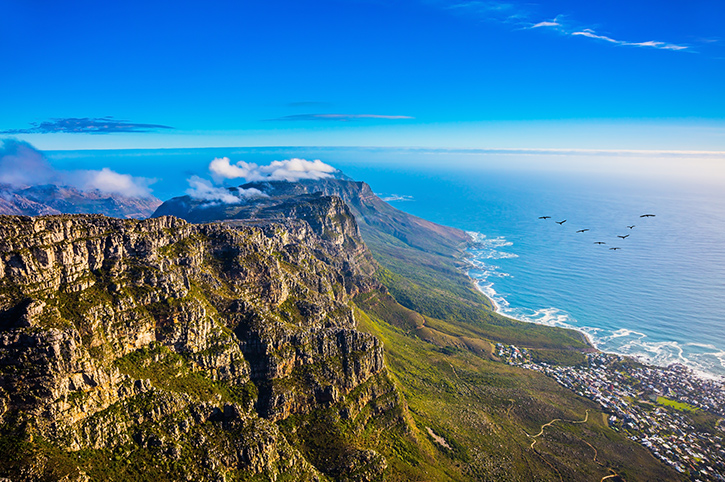
Formerly known as the Cape Peninsula National Park, the vast Table Mountain National Park stretches from just north of Cape Town all the way down the Cape Peninsula to Africa’s most southwestern extremity, the Cape of Good Hope.
The centrepiece of the National Park is the iconic, flat-topped Table Mountain, its 1,086m summit affording sweeping views of Cape Town and Table Bay. The top is reachable by cable-car or, for those who enjoy a challenge, by bicycle or foot.
Also located within Table Mountain National Park are the endangered African penguin colony at Boulders Beach (accessible by a boardwalk), Signal Hill viewpoint, Lion’s Head Mountain and Cape Point, at the Cape of Good Hope.
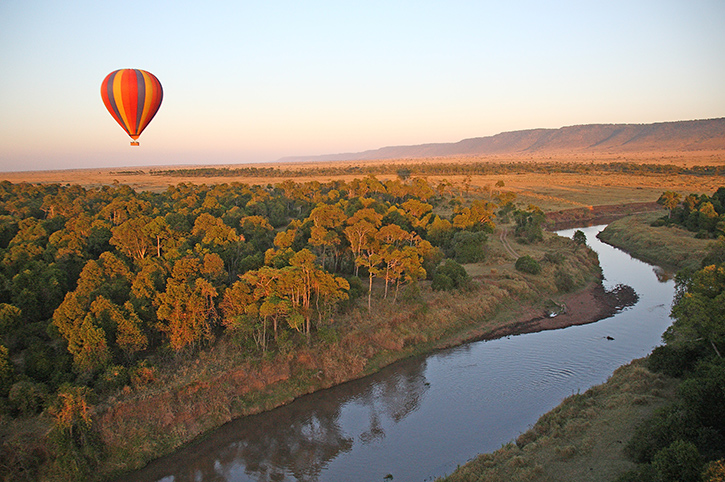
Before dawn you are woken from your slumber by a staff member knocking at your door with a cup of coffee in hand. When you are ready you are transferred to a nearby open grassland, where work on inflating the balloon has already begun. After a few bursts of the gas-burner, the balloon is upright and you are assisted into the basket, ready to go.
As the sun peeks over the horizon, the balloon lifts off and you rise above the tree-line to see the grasslands of the Masai Mara unfurl before you. Floating silently over this epic landscape gives a unique perspective on everything below. You can easily spot giraffe and larger herds of animals, and then you can start searching for the big cats through your binoculars.
Drifting on the breeze above the best that nature can provide; there is no experience quite like it. After an hour’s air-time the balloon descends and following a small bump on landing, you are assisted out of the basket, to be presented with a glass of champagne and breakfast in the savannah.
You can add a Masai Mara balloon flight to any of our safaris, however the nearest accommodation to the take-off point is usually Governers Camp. Please ask one of our Travel Experts if you would like to know more.

In the heart of the Rift Valley, surrounded by dense bushland, lies Lake Nakuru. It’s shallow depth and abundance of sunlight, create the perfect conditions for the growth of spirulina algea, the favourite food of Africa’s lesser flamingo, and the reason why the birds are such a beautiful pink.
In the surrounding National Park live hippo, giraffe, zebra, lion and leopard, as well as some breeding pairs of endangered black rhino, who use the mud at the edge of the lake to wallow. Spot them for yourself on a Kenyan safari.
A potential sign of climate change, in recent years heavy rainfall has caused Lake Nakuru to swell, with the increased depth resulting in less algae growth and therefore less food for the flamingos. Whether this will be temporary or permanent remains to be seen.

In the southern most part of Mozambique lies an unspoilt African wilderness. The Machangulo Peninsula is bordered by the Bay of Maputo on the western side and the deep blue of the Indian Ocean to the East. Then to its southern border is a safari game reserve. The peninsula itself boasts more than 20 kilometres of gloriously golden, sandy beach, that is not only perfect for a relaxed sunbathe, but is also home to protected turtles and other indigenous wildlife.
The Machangulo Beach Lodge is ideal for people who want to relax and explore the beautiful beaches of Machangulo. An elevated position on the sand dunes gives spectacular views over pristine beaches and the azure sea, whilst at lower levels, walkways meander through the cool coastal forest creating a natural and secluded feel.

The orange and red tinted layers of the sedimentary rocks through which the Blyde River has carved South Africa’s largest canyon, wonderfully compliment the deep greens of the sub-tropical vegetation that thrives in the region.
Found in the eastern province of Mpumalanga, Blyde River Canyon is a highlight of the Panorama Route, a stunningly scenic drive from Long Tom Pass, just outside the town of Lydenburg, to the provincial border with Limpopo, near Echo Caves, with geographical wonders and waterfalls aplenty en route.

Part of Africa’s Great Rift Valley, the Ngorongoro Crater is the remains of a collapsed volcano. The crater is particularly remarkable as the rim of the volcano remains intact, creating a natural barrier between those inside and the Highlands that surround it.
The Ngorongoro Crater contains a large resident animal population including the “Big 5” of lion, leopard, rhino, elephant, and buffalo. In fact, all of Africa’s most recognisable animals are present, with the exception of giraffe, that find the steep slopes to difficult to access. The concentration of bird life is exceptional too, with flocks of flamingo often trawling the shallows of the crater lake.
The Ngorongoro Crater is close to the Serengeti and Tarangire National Park, making it a great option to visit for those looking for a taste of Tanzania.

Almost a quarter of the spectacular Etosha National Park in northern Namibia is covered by a salt pan, which remains dry for most of the year, filling briefly after summer rains when flamingos and pelicans arrive.
The nutrient-rich dust from the pan gets blown across the park, fertilising the otherwise arid plains and stimulating enough vegetation growth to support a surprisingly large number of elephant and other herbivores, preyed upon by lion and leopard, plus an important population of black rhino.
Game drives in Etosha are excellent, especially in the dry season between May and October as animals converge on numerous waterholes.

Bordering the Serengeti, the Mara Triangle is the entrance and exit point into the Masai Mara National Reserve for over a million wildebeest and tens of thousands of zebra and gazelle each year, as they follow the rains in search of fresh vegetation.
The zebra in this photo are crossing the Mara River, which being home to 4 metre long Nile crocodile, is often the most dangerous part of their journey. Fortunately for them, it appears they have so far only been spotted by a group from Governors Camp, where you can stay in luxury tented accommodation and spot elephant and hippo from your balcony as they head to the river to drink or cool off.

African buffalos are a force to be reckoned with, typically weighing aroud 750 kg and reaching a shoulder height of 1.5 metres. If an individual is attacked by lions, the herd will come to its defence, which often being over 100 animals strong, is enough to make even a hungry pride think twice.
Their strength and unpredictability when wounded also earned the African buffalo its place in the ‘Big 5’, the species originally most feared by hunters, but now on most safari-goers tick list. There are roughly 35,000 buffalo in Kruger National Park, so it’s unusual not to spot them on a South African safari, be it a self drive through the reserve or guided tour from a game lodge.
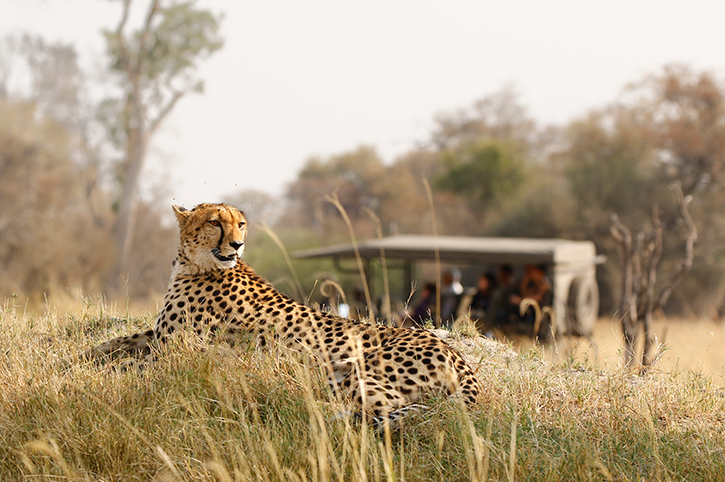
Whilst Chobe National Park is best known for its wildlife-rich riverbanks, where it’s not unusual to see lion, elephant and hippo in one eyeshot, in the southwest of the reserve is an area offering an equally enchanting safari experience.
Savuti is known for its ‘fickle’ marsh which lies dry for years and then curiously fills up with water, attracting great herds of herbivores and in turn, big cats and other predators. The marsh is fed by the Savuti Channel, a 100 km off-shoot of the Chobe River. Whilst currently flowing, dead trees line the banks from the 1980’s and 1990’s when it sat empty and arid.
Our Best of Botswana fly-in safari spends two nights in the Savuti between visiting the Chobe riverbank and Okavango Delta. Staying at the Savute Safari Lodge, an experienced ranger will take you in search of the famous ‘Marsh Pride’ of lions, the only known group to actively hunt fully-grown elephant.

The Robberg Nature Reserve occupies a rocky peninsular that juts out into the Indian Ocean, just south of the town of Plettenberg Bay.
There is a choice of three walking trails around the reserve that range between 2.1 and 9.2 km in distance, over cliffs, beaches, sand dunes and boardwalks. Resident seals and kelp gulls can usually be seen, as well as terns, gannets and cormorants if you reach The Point. From June to November, southern right whales can also be spotted, on their return to South African waters to bread and calve.
Robberg Nature Reserve and Plettenberg Bay, with its 4 km beach, are both well worth a stop for those travelling the Garden Route or make an excellent afternoon out if staying in nearby Knysna.

The Serengeti is home to almost 10% of Africa’s 32,000 lions, making it an essential inclusion in a Tanzania safari if you are keen to see the undisputed king of the savannah.
Despite their fearsome reputation, lions are social animals, and in the Serengeti in particular, it is possible to view large prides living harmoniously. However, don’t expect to see a great deal of activity; lions like to snooze for around 20 hours every day, so when you do catch up with a pride, expect them to mostly be sleeping!
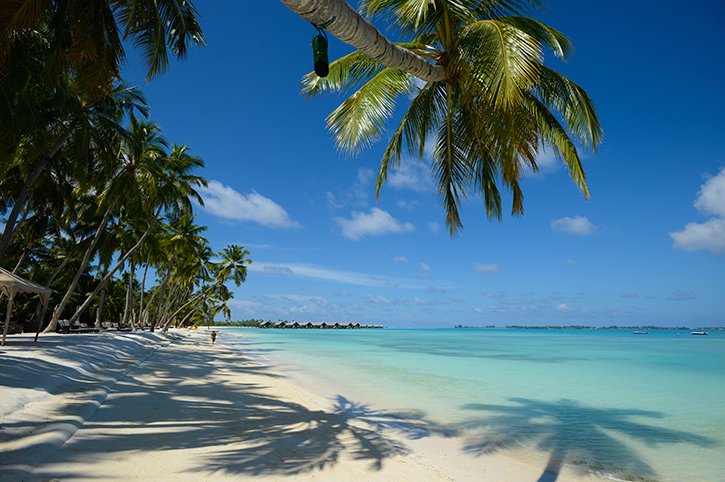
You don’t have to go far to find your own stretch of soft sand wherever you are staying in Mauritius. And with its sub-tropical climate, averaging 27°C between November and April and 22°C between May and October, the water is always warm – perfect for snorkelling over the fringing coral reefs.
If you can drag yourself away from the beach, there are botanical gardens, mountains and lush National Parks to explore inland, as well as the capital Port Louis on the west coast, with its colourful markets and irresistible Indian, African and Chinese inspired street food.
Mauritius is open and quarantine-free for fully vaccinated travellers. If you would like a week or two in tropical paradise please browse our choice of Mauritius beach resorts then get in touch with our team who’ll find you the best rates and most convenient international flights.
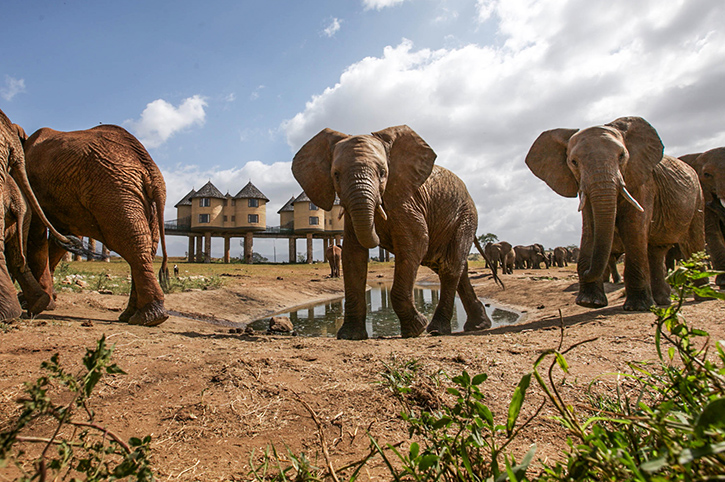
The quite unique Salt Lick Safari Lodge sits above the plains of Taita Hills Wildlife Sanctuary, which shares an unfenced border with Tsavo West National Park in southern Kenya.
From your private balcony or the terraced bar, it’s easy to let hours drift by watching the herds of elephants, antelopes, zebra and buffalo that frequent the waterhole. For a close up view, you can take an underground tunnel to a bunker with ground level windows, where you can watch the wildlife drink and cool down.
Lion, giraffe and ostrich are regularly sighted on game drives from the lodge, with the more fortunate also seeing leopard, honey badger and white-tailed mongoose on night safaris.
For those staying by the Mombasa coast, the Taita Hills Wildlife Sanctuary and Tsavo National Parks can be reached in just a few hours, such as on our Salt Lick Rail Safari, which includes two nights at the lodge, and popular nine day Kenya Beach & Safari Experience, which stays in the nearby Ngutuni Game Reserve.

Located in the Namibian side of the |Ai-|Ais/Richtersveld Transfrontier Park, which crosses the border into South Africa, Fish River Canyon is the second largest in the world, after the Grand Canyon in the USA.
Carved out over millions of years by the Fish River, the canyon extends 161 km, reaching 27 km wide at points and 549 metres deep. River levels through the canyon are controlled by the Hardap Dam, upstream in central Namibia, and by the country’s extreme climate. During peak rains you’ll find raging torrents, but the rest of the year just a chain of narrow pools.
At the southern end of the Fish River Canyon is the resort town of ǀAi-ǀAis, famous for its hot springs and a stopping point on several of our safari tours of Namibia and Southern Africa, which journey from Cape Town to Victoria Falls.

In fact an archipelago of 51 islands, the name Zanzibar is commonly used, by locals and visitors, to refer to Unguja, the largest isle in the group and location of the main airport and majority of beach resorts and hotels.
A synonym for tropical serenity, Zanzibar is a wonderful holiday destination in its own right, or the perfect second half of Tanzania safari and beach holiday. The flight from Arusha, the gateway to the National Parks of Tanzania’s renowned ‘Northern Circuit’, takes just over one hour.
There is a wonderful choice of beach resorts in Zanzibar, plus coral reefs, mangrove forests and spice plantations to explore, if you can drag yourself away from the sands!

It’s typically August each year when over a million wildebeest, accompanied by vast herds of zebra, impala, eland and gazelle, risk their lives crossing the crocodile infested Mara River to reach the fertile savannah of the Masai Mara.
No one knows for sure what makes these wildebeest do it, in other parts of Africa they’re a non-migratory species, but over 12 months they complete a 1,000 km journey, covering swathes of the Serengeti National Park and Ngorongoro Conservation Area, in addition to their Kenyan soiree.
If you would like to witness the Great Wildebeest Migration yourself, please speak with our Africa Experts who can recommend a suitable Kenya safari or Tanzania safari and advice on the best time to travel.
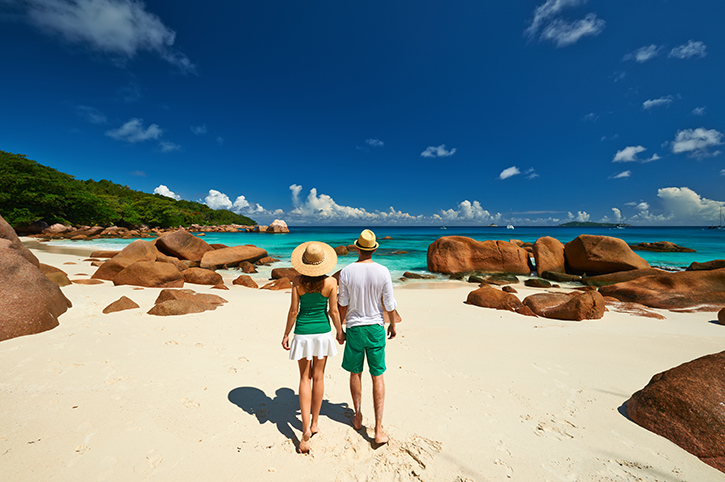
Picture tropical paradise in your mind and our bet is that it won’t look too different from Anse Lazio Beach, on the northwest of Praslin, the Seychelles’ second largest island.
You’ll find plenty of space to yourself along its 300 metre stretch of soft, white sand, and intimate coves and picturesque granite boulders to explore at each end. The Indian Ocean water is warm and clear, and resident tropical fish curious, making it a fun place to snorkel.
Our 8 day Seychelles Island Odyssey itinerary includes a stay on both Mahe and Praslin and a day trip to the beautiful La Digue. Another popular option is to combine the Seychelles and Kenya, for a safari and beach adventure.

Big cats, such as this resting lioness, are common in the Kgalagadi Transfrontier Park, which largely sits in the Kalahari Desert, straddling the Botswanan and South African border. They roam the arid environment in search of wildebeest, hartebeest, springbok and eland which migrate through the park.
The sparse vegetation provides for excellent game viewing, especially from March through to May as the rainy season comes to an end and wildlife doesn’t stray too far from the rapidly drying riverbeds, the last easy water source. The park’s red sand dunes also provide an epic backdrop.
The Kgalagadi Transfrontier Park offers a more off-the-beaten-track safari experience than such as Kruger National Park. Speak with our team to include it in a tailor made South Africa holiday.

South Africa’s coastal province of Kwa-Zulu Natal has the second largest population of white rhino in the world, most of which live in the hilly Hluhluwe-iMfolozi Game Reserve. It was in fact the discovery of 40 Southern white rhinos in 1894 that led to the reserve’s designation a year later, to protect the species which had been presumed hunted to extinction.
Hluhluwe-iMfolozi Game Reserve is also home to an important population of the critically endangered black rhino, of which there are just 5,000 living in the wild, as well as the other members of the ‘Big Five’.
Located within the reserve, Rhino Ridge provides its guests morning and afternoon game drives, led by experienced guides who rarely fail to spot white rhino at the least. A stay at the luxury safari lodge can be included in a tailor made South Africa holiday.

The arid climate of Amboseli National Park is caused by its towering Tanzanian neighbour, Mount Kilamanjaro, prompting the moisture in the prevailing air flow from the Indian Ocean to discharge as rainfall before it reaches the park. This results in superb game viewing, as vegetation is low to the ground and birds and wildlife cluster around what limited water sources there are.
Amboseli is known as one of the best places in the world to observe elephants, but is also home to cheetahs, lions, hyenas, giraffes, zebras, wildebeests and buffalo, as well over 400 species of birds, including kingfishers and pelicans.
You can visit Amboseli National Park on an eight day Kenya Favourites safari including the Masai Mara and Lake Nakuru or as part of a Kenya safari and beach holiday.
We update this page each week, with the featured image from our e-newsletter, which you can sign up to in the footer below.